Do you feel like your business gets lost on Google’s search engine results page (SERPs) even though you’ve invested heavily in search engine optimization (SEO)? If so, consider elevating your SEO strategy by leveraging Schema Markup.
Schema Markup, also known as Structured Data, is a standardized vocabulary that helps search engines like Google understand the information on your web pages.
When your pages contain Schema Markup, this enables the search engine to display your content as a rich result. These rich results are displayed prominently on the SERP and include extra information about a page, like ratings and reviews of local businesses.

The whole point of SEO is to increase your web traffic and conversions. Schema Markup can help you accomplish both goals and even allows you to measure the results of your efforts using tools like Google Search Console.
Here are some of the top benefits of Schema Markup.
1. Help Search Engines Better Understand Your Content
Humans are great at inferring the meaning of online content. Google, on the other hand, has to teach its tech to understand your content using machine learning.
That’s why the search engine needs some extra help interpreting the purpose of your site content. You can assist them by adding Schema Markup to your web pages.
Schema Markup is a standardized vocabulary developed by Google, Yandex, Yahoo, and Bing. As such, these search engines can easily interpret the Structured Data on your page, allowing the algorithms to present users with content that better aligns with their search intent. It also helps search engines be more efficient because their machine learning and algorithms are built to understand the Schema Markup.
2. Help You Stand out in Search with Rich Results
When Google understands your Schema Markup, it can use this data to show your content as a rich result (also known as rich snippets) on the SERP.
A standard search result will deliver a title, URL, and meta description. However, rich results include captivating images that draw users’ eyes to your search result and web page.
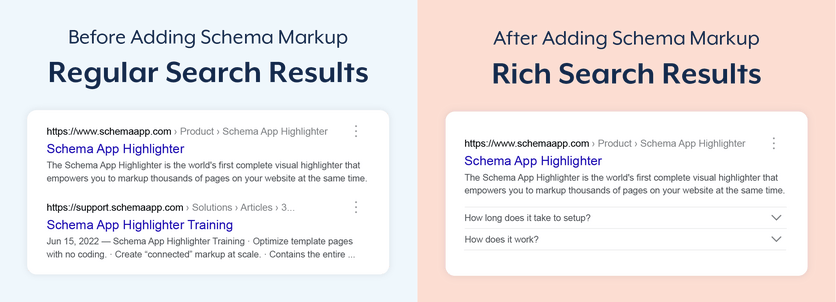
In total, Google has more than 32 different types of rich results. You can classify your content as FAQs, local business content, videos, articles, event pages, and more. If you’re promoting an event, you can improve its visibility by adding Event Structured Data, making your page eligible to appear in the event experience section on Google.
Once you add Schema Markup to your page, you can use Google’s rich results test to see which rich result your page is eligible for. We also suggest using the Schema Markup Validator on Schema.org to detect any mistakes in your Structured Data.
3. Control How Your Brand Appears in Search
Adding Schema Markup to your web pages lets you exercise greater control over your brand’s appearance in search. If you want to ensure that your Schema Markup efforts align with your overall branding strategy, here are some examples of rich results you can consider using.
Review Snippets
Review snippets provide prospective customers with reviews and ratings from your past customers and help improve your brand’s credibility in search results.

Product
Product rich results reveal sought-after details like pricing, availability, etc. You can generate more leads and increase interest in your product offerings by providing consumers with this information on the SERP. Beyond the fundamentals, you can also expand your Product rich result to include price drops, ratings, reviews, shipping details and more.

How-To
How-to rich results show prospective customers how to use your services or products. Highlighting these types of pages also helps establish your brand as a source of authority in your industry, which can make readers more trusting of your content.

FAQ
Frequently asked question (FAQ) rich results provide users with answers directly on the search results page. This can reduce customer support costs and help your content reach the right users.
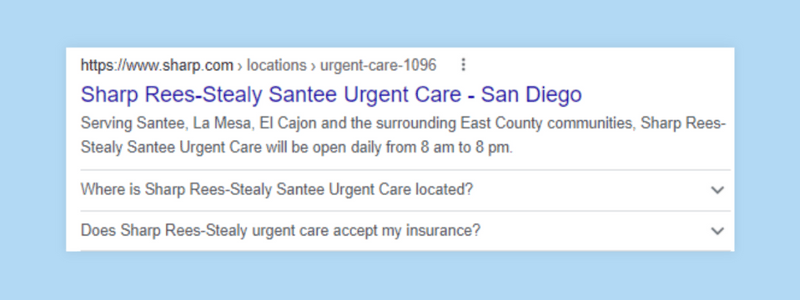
4. Drive Business Results
Schema Markup is an SEO strategy that can provide your company with measurable results and a strong return on investment.
You can use tools like Google Search Console and Schema Performance Analytics to closely monitor how your newly marked-up pages are performing. You’ll likely find that the pages with a rich result have a higher click-through rate than those without one.
Achieving robust results with Schema Markup isn’t unusual. At Schema App, we’ve seen customers across a wide range of industries achieve great results with this SEO strategy.
For instance, SAP saw a 400% growth in clicks from rich results after working with our team, and Sharp Healthcare enjoyed an 843% increase in clicks in just nine months.
5. Be AI Search Ready
Search engines are also shifting to using artificial intelligence to deliver answers to users’ queries. Implementing Schema Markup can likely help search engines better understand your content.
In Google’s podcast titled, “Structured Data, What’s it all about?”, Ryan Levering shared how machine learning and structured data go hand in hand. When you take into consideration that machine learning is the building block for AI, an action you can take to prepare for more AI in search (such as Bard and ChatGPT) is to adopt structured data to inform the machine learning about your content and have it be fully understood.
6. Delight Your Customers with Answers
The customer experience begins in search. It starts when they conduct a search to find a solution for a problem that they are looking to solve.
You can use Schema Markup to delight potential customers by answering common questions or providing them with product insights on their results page. Q&A and FAQ rich results are two of the most effective rich results types for enhancing the customer experience and streamlining the delivery of information to your target audience.
Example of a Q&A rich result
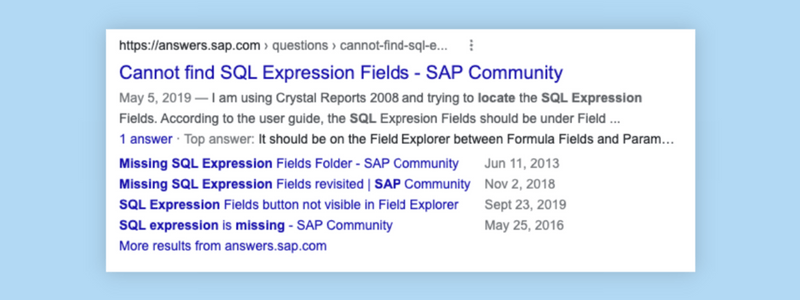
Example of a FAQ rich result
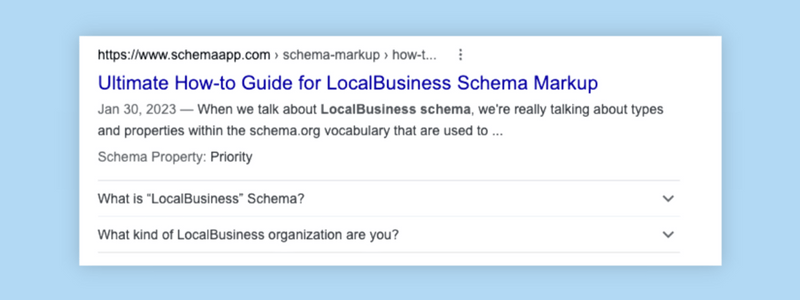
7. Attract Job Applicants
Schema Markup can also be incorporated into job postings to help you attract quality talent. By applying Structured Data to your job listing pages, your job posting will be eligible for display among Google’s job search experience results.
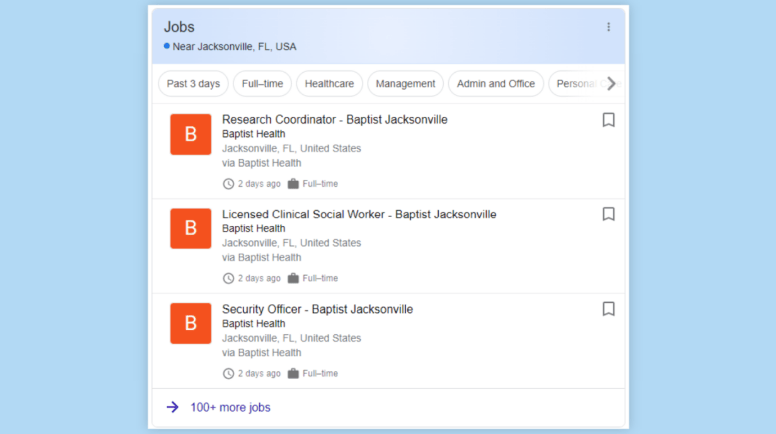
Top listings will be displayed at the top of the SERP. If your listings make the cut, they’ll feature reviews, ratings from past employees, job details, and your company logo.
8. Improve Your Content Strategy
Chances are that you’re already investing heavily in creating SEO content, optimizing it for priority keywords, and engaging in other on-page SEO tactics to rank higher on the SERP. Unfortunately, your competitors are likely doing the same.
Fortunately, you can beat the competition and inform your content strategy by utilizing Schema Markup. Thinking about your content from the perspective of the rich results you want to achieve can help to generate ideas for new content or existing content. If you want your page to be eligible for a Review Snippet, you can improve your content by adding customer reviews and ratings on your site.
Start by looking at Google’s Structured Data Guidelines, then generate the required Schema Markup using Google’s Structured Data Markup Helper or our Schema App Editor. Once you’ve generated the markup, you can add the Schema Markup to your pages so your content can stand out as a rich result.
You can go one step further to create connected Schema Markup by linking the topic covered in your content to the Wikipedia or Wikidata page for the specific topic within your Schema Markup.
Read our step-by-step guide to learn how to develop a Schema Markup strategy for your website.
9. Build a Knowledge Graph and Re-Use It Within Your Organization
At Schema App, we do more than just generate Schema Markup. We utilize our semantic technologies to generate connected Schema Markup so that the search engines can further understand HOW your content is connected to your organization and to other things on the web.
As a result, your Schema Markup is more than just a code you attach to a page. It creates a Knowledge Graph that explains the relationship between the entities on your page.
When you implement connected Schema Markup, you are defining the objects in your content as individual entities with their own properties and relationships to other entities. Once defined, these entities can be connected with the people, places, things and concepts that other authorities have described like Wikipedia, Wikidata, and Google’s Knowledge Graph. Your Schema markup can even enhance your Google Knowledge Panel in search.
Start implementing Schema Markup today
The benefits of Schema Markup are undeniable.
When you add Schema Markup to your website, you’ll help search engines understand your content and make your pages more visible in organic search. In turn, you’ll increase your click-through rates and generate more organic traffic for your web pages.
Any business with an online presence can generate measurable results using Structured Data. However, to tap into the full potential of Schema Markup and stand out online, you must build, manage and optimize it as part of your ongoing site strategy. Otherwise, you’ll encounter issues like Schema Drift which hinder your ability to achieve rich results.
The good news is you can streamline the implementation and management of your Schema Markup by working with Schema App. We work with enterprise SEO teams to fully leverage the benefits of Schema Markup. Contact us today to learn more.

Martha is the CEO and co-founder of Schema App. Schema App is an end-to-end Schema Markup solution that helps enterprise SEO teams create, deploy and manage Schema Markup to stand out in search. She is an active member of the search engine optimization community, and the work that she does through Schema App is helping brands from all over the world improve their organic search performance.
